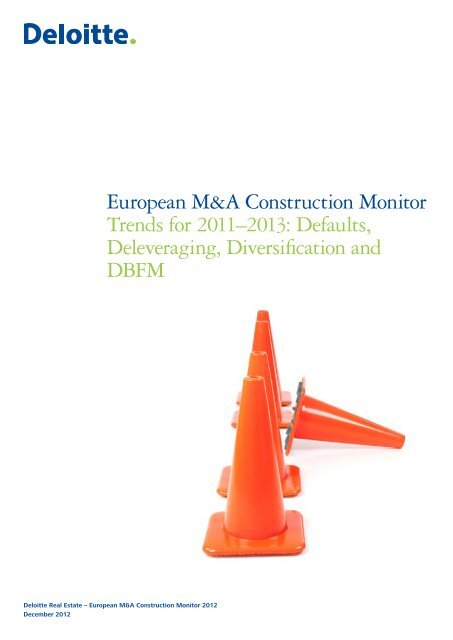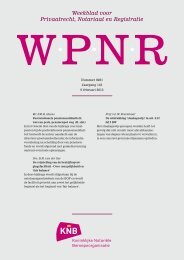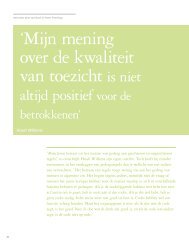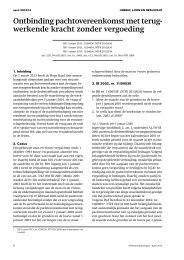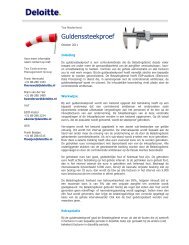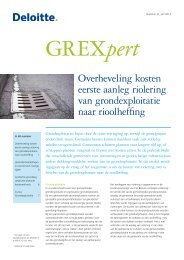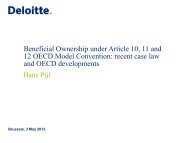European M&A Construction Monitor Trends for ... - Deloitte & Touche
European M&A Construction Monitor Trends for ... - Deloitte & Touche
European M&A Construction Monitor Trends for ... - Deloitte & Touche
You also want an ePaper? Increase the reach of your titles
YUMPU automatically turns print PDFs into web optimized ePapers that Google loves.
<strong>European</strong> M&A <strong>Construction</strong> <strong>Monitor</strong><br />
<strong>Trends</strong> <strong>for</strong> 2011–2013: Defaults,<br />
Deleveraging, Diversification and<br />
DBFM<br />
<strong>Deloitte</strong> Real Estate – <strong>European</strong> M&A <strong>Construction</strong> <strong>Monitor</strong> 2012<br />
December 2012
<strong>European</strong> M&A <strong>Construction</strong> <strong>Monitor</strong> is a publication<br />
edited and distributed by <strong>Deloitte</strong>.<br />
Director<br />
Jurriën Veldhuizen, partner Real Estate, The Netherlands<br />
Kees Zachariasse, M&A partner Real Estate, The Netherlands<br />
Coordinated by<br />
Harm Drent<br />
Hinse Boonen<br />
Steven Vrendenbarg<br />
Laurens Kil<br />
Contact<br />
Real Estate Department, <strong>Deloitte</strong> Netherlands<br />
Phone +88 288 3281<br />
Fax +88 288 9752<br />
jveldhuizen@deloitte.nl<br />
kzachariasse@deloitte.nl<br />
www.deloitte.nl/realestate<br />
December 2012
Contents<br />
1. Introduction 5<br />
2. Looking back 6<br />
3. Going <strong>for</strong>ward 12<br />
4. <strong>European</strong> construction and infrastructure group contacts 19<br />
<strong>European</strong> M&A <strong>Construction</strong> <strong>Monitor</strong> <strong>Trends</strong> <strong>for</strong> 2011–2013: Defaults, Deleveraging, Diversification and DBFM 3
1. Introduction<br />
M&A activity is expected to<br />
increase, although the average deal<br />
size will be smaller compared to<br />
previous years<br />
We are pleased to present the second edition of the<br />
<strong>European</strong> M&A <strong>Construction</strong> <strong>Monitor</strong>. This monitor looks<br />
at the latest trends and issues in Mergers & Acquisitions<br />
(M&A) in the construction industry. This 2012 publication<br />
complements the “<strong>European</strong> Powers of <strong>Construction</strong>”<br />
(EPoC) of 2011: a <strong>Deloitte</strong> research paper examining the<br />
status of major <strong>European</strong> listed construction companies.<br />
This monitor looks not only back at recent activities but<br />
also <strong>for</strong>ward. <strong>Deloitte</strong> has produced this outlook by<br />
combining the in-depth, local knowledge of its <strong>European</strong><br />
member firms on M&A, real estate, construction and<br />
infrastructure.<br />
Market trends: Defaults, deleveraging,<br />
diversification and DBFM<br />
The number of deals decreased in 2011 compared with<br />
2010. Uncertainty in the market was a major factor <strong>for</strong><br />
this decline. Although uncertainty remains omnipresent in<br />
2012, M&A activity is expected to increase, even though<br />
the average deal size will be smaller compared with<br />
previous years. Small and medium-sized companies are the<br />
main targets, provided they are of interest to the limited<br />
number of larger construction companies active in the<br />
<strong>European</strong> M&A market.<br />
Survival techniques – including deleveraging, diversification<br />
and reorganisations – have been and will continue to<br />
be applied to avoid defaulting on financial obligations.<br />
Companies that do not attract the attention of potential<br />
acquirers must be skilled in these techniques if they are to<br />
outlive financial turmoil and avoid financial distress. Many<br />
bankruptcies have been recorded in the last twelve months.<br />
Financially weak construction firms that remain inert,<br />
hoping <strong>for</strong> the economic situation to improve, could soon<br />
be heading <strong>for</strong> bankruptcy.<br />
We have also noted larger construction groups fleeing<br />
Europe to markets where there is either evidence of recent<br />
growth or expectation of growth in the near future.<br />
These markets include BRIC countries (Brazil, Russia India,<br />
and China), Australia and the Middle East. Conversely,<br />
non-<strong>European</strong> international construction groups are<br />
keeping an eye on the <strong>European</strong> construction industry to<br />
identify potential targets.<br />
This <strong>European</strong> M&A <strong>Construction</strong> <strong>Monitor</strong> presents<br />
analyses of market trends in the <strong>European</strong> construction<br />
industry: looking back but also looking <strong>for</strong>ward.<br />
<strong>European</strong> M&A <strong>Construction</strong> <strong>Monitor</strong> <strong>Trends</strong> <strong>for</strong> 2011–2013: Defaults, Deleveraging, Diversification and DBFM 5
2. Looking back<br />
6<br />
The <strong>European</strong> construction sector recorded 104<br />
deals in 2011 1<br />
Development 2011-2012 H1<br />
M&A activity within the <strong>European</strong> construction sector<br />
decreased in 2011 compared to the modest increase in<br />
activity the year be<strong>for</strong>e. In 2011, 104 deals were completed<br />
compared to 144 deals in 2010.<br />
In last year’s <strong>European</strong> M&A <strong>Construction</strong> <strong>Monitor</strong> we<br />
mentioned that the number of transactions was expected<br />
to increase in the medium to long term, depending on the<br />
availability of cash and other effects of the slow economic<br />
recovery. A year later, we can conclude that M&A activity<br />
has been adversely affected by the economic downturn<br />
and the contraction of available cash in the financial<br />
markets. This effect was felt most in 2011.<br />
With 72 transactions in the first half of 2012 (2011 H1: 65<br />
deals), the total number of deals in 2012 is expected to<br />
be higher than the 104 deals recorded in 2011 (including<br />
2012 H2 projection based on linear extrapolation).<br />
Nevertheless, the deal value of individual transactions is<br />
expected to be lower than previous years.<br />
<strong>Construction</strong> companies are broadening their traditional<br />
construction offering by acquiring smaller, add-on and<br />
niche companies which operate in other industries. This<br />
trend in diversification has resulted in more cross-sector<br />
mergers, with the aim of reducing the dependency on the<br />
struggling construction markets. The number of crossborder<br />
deals increased from 30% of recorded deals in 2010<br />
to just under 40% of recorded deals in 2011.<br />
M&A activity <strong>European</strong> construction industry<br />
Number of deals<br />
300<br />
250<br />
200<br />
150<br />
100<br />
50<br />
0<br />
1 A deal is a transaction involving at least 30% of the shares of a <strong>European</strong> construction company<br />
This significant increase is in line with last year’s<br />
internationalisation expectations. Since transactions were<br />
conducted mainly by international construction groups<br />
and conglomerates, the increasing presence of large,<br />
international and multi-disciplined construction companies<br />
is becoming stronger.<br />
Last year we introduced and discussed the following<br />
trends: sector diversification and internationalisation.<br />
This year we will discuss the market trends of defaulting<br />
construction companies and deleveraging strategies. We<br />
will also discuss diversification (a follow-up on last year’s<br />
trends) and DBFM.<br />
Trend 1: Defaults<br />
A large number of construction companies throughout<br />
Europe are currently defaulting on their financial<br />
obligations. Significant pressure on pricing is the main<br />
reason. This pressure is due to overcapacity in the<br />
market, which in turn is a result of the limited number of<br />
construction projects, the limited availability of funding<br />
and the low level of economic activity in the region. The<br />
pipeline of available work is running low throughout<br />
Europe, and is almost dry in Southern and Eastern<br />
<strong>European</strong> countries.<br />
The impact of the crisis is most significant on small and<br />
medium-sized companies because they do not have the<br />
financial resources or buffers to diversify or raise capital.<br />
Nowadays, diversification and funding appear necessary<br />
because the lack of large contracts is causing large<br />
corporations to chase smaller contracts. This had led to a<br />
distorted market.<br />
2007 2008 2009 2010 2011 2012 H1<br />
Deals Projection H2 2012
Insolvencies per 10,000 companies in Europe*<br />
*excluding Central and Eastern Europe<br />
120<br />
100<br />
80<br />
60<br />
40<br />
20<br />
0<br />
2008 2009 2010 2011<br />
Smaller companies are typically acquired when they<br />
become financially distressed. The distressed or defaulted<br />
company becomes a target if it has certain specialist<br />
(“niche”) skills, a reasonable order portfolio and/or a<br />
presence in a market that the acquirer wishes to enter.<br />
Un<strong>for</strong>tunately, many of these distressed companies do<br />
not fit the requirements of acquirers currently active in<br />
the market. This has resulted in a wave of unsold smaller<br />
companies throughout Europe. Unless they are skilled in<br />
survival techniques, these companies face a constant threat<br />
of insolvency, default and – lastly – bankruptcy.<br />
Insolvency is the inability to meet one’s debt obligations.<br />
The figure above shows the number of insolvencies per<br />
10,000 companies in Europe (excluding Central and<br />
Eastern Europe) in four sectors: construction, commerce,<br />
manufacturing and services. The construction sector<br />
recorded the most insolvencies. The trend is rising, which<br />
may indicate an increase in future bankruptcies.<br />
The effect of large sporting events on the local construction<br />
sector has been remarkable. Local <strong>Deloitte</strong> specialists have<br />
indicated the termination of large sporting events as an<br />
immediate cause <strong>for</strong> a sharper increase in the number of<br />
defaults.<br />
<strong>Construction</strong> Commerce Manufacturing Services<br />
A good example is EURO 2012 in Poland and Ukraine.<br />
The football tournament attracted large infrastructural<br />
and construction projects to improve logistics <strong>for</strong> the<br />
large crowds attending the event. This subsequent peak<br />
in construction in the period be<strong>for</strong>e the event led to<br />
construction companies adjusting their capacity plans.<br />
However, the beneficial effect of EURO 2012 was shortlived.<br />
Considerably fewer construction projects have<br />
followed after this peak and this bodes ill <strong>for</strong> construction<br />
companies. A further rise in defaults is expected.<br />
Bankruptcy PBG<br />
In June 2012, Polish-based PBG announced<br />
bankruptcy. The group, which was Poland’s third<br />
largest builder, was responsible <strong>for</strong> constructing<br />
three of the four stadiums <strong>for</strong> the 2012 <strong>European</strong><br />
Football Championship. The company, which<br />
originally specialised in oil and gas engineering,<br />
tendered <strong>for</strong> the arenas and road works of EURO<br />
2012. Once they had won the contracts, their debt<br />
levels soared and their margins were squeezed,<br />
resulting in large negative cash flows. The company<br />
generated revenue of over EUR 900 million and had<br />
more than EUR 1.5 billion of assets in 2011.<br />
<strong>European</strong> M&A <strong>Construction</strong> <strong>Monitor</strong> <strong>Trends</strong> <strong>for</strong> 2011–2013: Defaults, Deleveraging, Diversification and DBFM 7
8<br />
Trend 2: Deleveraging<br />
Most construction companies use leverage, i.e. debt, to<br />
finance investments and operations. Un<strong>for</strong>tunately, leverage<br />
magnifies both gains and losses, thereby increasing the risk<br />
of default. Deleveraging – a company’s attempt to decrease<br />
its amount of debt financing – is an important survival<br />
strategy <strong>for</strong> many construction companies throughout<br />
Europe. Deleveraging can be done by divesting a company<br />
of its assets and non-core activities, by selling additional<br />
equity to private equity firms or by exchanging debt-<strong>for</strong>equity<br />
investments. Divestment reduces the overall financial<br />
risk of the company and can generate additional funds <strong>for</strong><br />
more liquidity. The cash generated can be used to provide<br />
an equity buffer <strong>for</strong> new investments or to reduce debt<br />
and, there<strong>for</strong>e, the risk of default.<br />
Historically, the working capital of construction companies<br />
was financed by milestone payments from their clients;<br />
there<strong>for</strong>e, additional financial resources were seldom<br />
required <strong>for</strong> working capital facilities. However, the<br />
unfavorable economic climate of the last few years and the<br />
lower number of contracts has resulted in the negotiation<br />
of these favourable conditions by clients. Consequently,<br />
construction companies have had to find other ways of<br />
financing work in progress, shifting a significant share<br />
of the financial risk from the client to the construction<br />
company.<br />
This fundamental change in the business model has<br />
made it necessary <strong>for</strong> most companies to restructure their<br />
balance sheets and financial reserves. The low availability<br />
of credit throughout the <strong>European</strong> financial markets, partly<br />
caused by a host of new regulations such as Basel 3 and<br />
Solvency 2, has <strong>for</strong>ced companies to consider deleveraging.<br />
Divestment of non-core activities or assets generates<br />
additional cash, reduces risk and improves the company’s<br />
efficiency by shifting its focus to its core business. Overall,<br />
construction companies reduced their net debt by 3% 2 in<br />
2011. We expect a further reduction in 2012 and beyond.<br />
2 <strong>European</strong> Powers of <strong>Construction</strong> (EPoC) 2011<br />
Another trend is the increasing interest of private equity in<br />
construction companies. Private equity firms acquire stakes<br />
in a company using a debt-<strong>for</strong>-equity swap: private equity<br />
is used to redeem debt, improving the debt-to-equity ratio.<br />
An alternative method is to issue more equity or by selling<br />
private equity firms a stake in existing equity.<br />
Selling equity to private investors means passing partial<br />
control to others while keeping a strong balance sheet<br />
with healthy financial ratios. These strong financial ratios<br />
and larger cash supplies enable companies to initiate new<br />
investments and negotiate more favourable terms <strong>for</strong> their<br />
debt covenants.<br />
Deleveraging through asset sale – Ferrovial<br />
A notable case of deleveraging by selling assets is<br />
the sale by Ferrovial of a 10.62% stake in BAA Ltd<br />
to Qatar Holding LLC <strong>for</strong> GBP 478 million in August<br />
2012. BAA Ltd owns, amongst others, Heathrow<br />
and Stansted airports in London. The sale of these<br />
shares follows an already extreme deleveraging<br />
strategy of 74% (EUR 14,618 million) of Ferrovial’s<br />
net debt in 2011.<br />
Private equity – Miller Group<br />
An example of the increase in private equity is<br />
the acquisition in December 2011 of a controlling<br />
stake in house building, property development and<br />
construction company Miller Group by GSO Capital<br />
Partners (a subsidiary of The Blackstone Group,<br />
United States) with a deal size of GBP 160 million<br />
(involving a capital injection and a debt-<strong>for</strong>-equity<br />
swap). This transaction improved Miller’s debt-toequity<br />
ratios, allowing it to refinance its remaining<br />
debt <strong>for</strong> more favourable conditions.
Trend 3: Diversification and DBFM (PPP)<br />
Excess capacity and pressure on margins have resulted<br />
in companies seeking other opportunities to remain<br />
profitable during a widespread economic downturn.<br />
Similar to last year, and in line with the expectations of<br />
international <strong>Deloitte</strong> specialists, we have seen an increase<br />
in diversification through cross-border and cross-sector<br />
M&A activity. These acquisitions remain popular in volatile<br />
markets because they ensure sustainable long-term<br />
profitability.<br />
We have also seen around the world an increasing number<br />
of PPPs. Public Private Partnerships in infrastructure and<br />
construction projects are often structured as long-term<br />
DBFM contracts (Design Build Finance Maintain).<br />
<strong>Construction</strong> companies participating in these structures<br />
extend their involvement in the project (value chain<br />
integration); a specific <strong>for</strong>m of diversification.<br />
A. Internationalisation: cross-country and<br />
cross-continent<br />
Previously, diversification happened mainly across other<br />
<strong>European</strong> countries. Focus has now shifted to the BRIC<br />
countries (Brazil, Russia, India and China), Australia and the<br />
Middle East. These countries are expected to be responsible<br />
<strong>for</strong> more than half of the worldwide infrastructure<br />
investments in the coming years. This creates a sustainable<br />
growth market <strong>for</strong> local companies as well as <strong>for</strong> <strong>for</strong>eign<br />
companies who enter the market at an early stage.<br />
Entrance to these markets is mainly executed through joint<br />
ventures, mergers, public private partnerships (PPPs) and<br />
selected tenders.<br />
The internationalisation trend is being driven mainly by<br />
large, cash-rich construction companies that currently<br />
have the financial resources to pursue this strategy.<br />
We also see an increasing amount of investment in<br />
Europe by Chinese firms. Cash-rich Chinese construction<br />
companies are looking <strong>for</strong> opportunities to expand<br />
into new markets by extending their construction and<br />
technological knowledge. An example from earlier this<br />
year (February 2012) is the acquisition of Putzmeister,<br />
a German-based manufacturer of concrete pumps, by<br />
Sany Heavy Industry from China. The transaction price<br />
was USD 525 million. More cross-continental acquisitions<br />
between China and Europe are expected.<br />
Cross-continental diversification – Bilfinger<br />
German-based Bilfinger SE acquired Indian-based<br />
Neo Structo <strong>Construction</strong> Ltd <strong>for</strong> a non-disclosed<br />
priced on 23 November 2011. This acquisition in the<br />
Indian industrial service market marks the German<br />
company’s first entry into the Asian continent.<br />
Some of Neo Structo’s clients were already being<br />
served by Bilfinger in other countries. The Indian<br />
company currently employs 1,600 people and has<br />
an enterprise value of EUR 60 million. Neo Structo<br />
focuses on the maintenance, manufacturing and<br />
installation of facilities in the process industry,<br />
which greatly resembles Bilfinger’s current business<br />
model. This is the first overseas cross-continental<br />
diversification <strong>for</strong> Bilfinger.<br />
<strong>European</strong> M&A <strong>Construction</strong> <strong>Monitor</strong> <strong>Trends</strong> <strong>for</strong> 2011–2013: Defaults, Deleveraging, Diversification and DBFM 9
10<br />
Companies based in Southern Europe are moving towards<br />
projects in Northern Europe, a more stable part of the<br />
continent economically. There is also an increasing<br />
amount of shorter-term, project-based internationalisation<br />
between these regions. In Southern Europe, the amount of<br />
available work is decreasing rapidly, but in some countries<br />
in Northern Europe, the economy is starting to stabilise.<br />
Cross-border interference is putting even more pressure<br />
on the margins of local companies, creating the need to<br />
diversify into other more profitable sectors.<br />
As stated be<strong>for</strong>e, the number of cross border deals<br />
increased from 30% of 144 recorded deals in 2010 to just<br />
under 40% of 104 recorded deals in 2011. The absolute<br />
number declined slightly in 2011 (41) compared to<br />
2010 (44). However, we expect this number to increase in<br />
2012. We also expect more cross-continental deals at the<br />
expense of fewer cross-border deals within Europe. This<br />
follows the trend of the increasing number of overseas<br />
acquisitions by <strong>European</strong> companies.<br />
Cross border deals within Europe and cross continental deals<br />
Total number of cross border deals<br />
90<br />
80<br />
70<br />
60<br />
50<br />
40<br />
30<br />
20<br />
10<br />
0<br />
81 81<br />
28 31<br />
53 50<br />
B. Sector diversification<br />
Cross-sector acquisitions not only reduce dependence on<br />
the current volatile construction market but also increase<br />
opportunities to create synergies within the value chain and<br />
boost overall profitability. Our dataset of deals shows an<br />
increase in cross-sector deals. A more significant increase<br />
in cross-sector M&A activity has been observed when it<br />
comes to smaller-sized companies, which fall outside the<br />
scope of this research paper.<br />
Since the <strong>European</strong> construction market is deteriorating,<br />
construction companies are looking <strong>for</strong> opportunities to<br />
diversify their activities by entering other, more profitable<br />
sectors. These mergers are mainly within higher value or<br />
service industries like telecommunication, green energy and<br />
motorway operations because they complement current<br />
core business expertise. However, the average deal size<br />
of mergers within the construction industry continued to<br />
decrease in 2011 because these more knowledge-driven,<br />
add-on companies are situated mainly in less capitalintensive<br />
niche markets and are, there<strong>for</strong>e, generally<br />
smaller in size. Logically, the growing amount of defaults<br />
and financial problems experienced by small and mediumsize<br />
companies is increasing the possibility <strong>for</strong> larger<br />
companies to adopt this strategy. There<strong>for</strong>e, we expect a<br />
further increase in sector diversification.<br />
44 44<br />
41<br />
14 17 13<br />
30 27 28 26<br />
2007 2008 2009 2010 2011 2012*<br />
Cross border deals within Europe Cross continental deals<br />
*incl <strong>for</strong>ecast 2012<br />
H2<br />
54<br />
28
C. Design Build Finance Maintain<br />
As stated earlier, in addition to sector diversification we<br />
also see an increase in vertical integration of the value<br />
chain. In the current economic climate, the life cycle of<br />
buildings is starting to take a more prominent role in the<br />
construction of real estate. This results in construction<br />
contracts which integrate the DBFM of infrastructure or<br />
building projects <strong>for</strong> the entire life cycle. It means contracts<br />
can often run <strong>for</strong> up to 50 years, generating stable and/<br />
or more secure cash flows <strong>for</strong> the parties involved. It also<br />
results in cost reductions because overhead costs and<br />
overall risk are limited.<br />
These DBFM contracts are often created as a partnership<br />
between public and private parties (PPPs). Within this<br />
partnership, the public party receives guarantees of costs,<br />
scheduling, materials and operations <strong>for</strong> the entire duration<br />
of the project. <strong>Deloitte</strong> specialists have noted this solution<br />
is gaining in popularity. It offers construction companies<br />
the opportunity to initiate cross-border and cross-industry<br />
partnerships with diversified risks and reduced initial<br />
start-up costs.<br />
We <strong>for</strong>esee an increasing interest in international<br />
infrastructure projects by <strong>European</strong> construction<br />
companies. An example in this is the partnership between<br />
construction companies Hochtief (Germany), ACS (Spain)<br />
and Meridiam (France/North America) to carry out the<br />
USD 1.5 billion project on the North East Anthony Henday<br />
Drive in Canada. The DBFM contract will run <strong>for</strong> 30 years<br />
and includes operation and maintenance of the existing<br />
highway infrastructure.<br />
There is also increasing opportunity in Europe <strong>for</strong> large<br />
<strong>European</strong> builders to get involved in DBFM contracts.<br />
Two examples of international interest are located in the<br />
Netherlands. Currently, the A15 motorway is being built<br />
by a consortium composed of Strukton and Ballast Nedam<br />
(Netherlands), John Laing (UK) and Strabag (Austria).<br />
In the first bidding round of the A1/A6 motorway, a<br />
losing consortium included Acciona (Spain) and Besix<br />
(Belgium). One of the three teams that advanced to the<br />
next round included a consortium of FCC (Spain), Strukton<br />
CC (Netherlands) and John Laing (UK). Even though it is<br />
unclear which companies will carry out this DBFM project,<br />
it is clear that there is a growing presence of international<br />
construction companies in local PPP and DBFM markets.<br />
<strong>European</strong> M&A <strong>Construction</strong> <strong>Monitor</strong> <strong>Trends</strong> <strong>for</strong> 2011–2013: Defaults, Deleveraging, Diversification and DBFM 11
3. Going <strong>for</strong>ward<br />
The outlook on M&A activity in Europe<br />
M&A activity in the construction industry <strong>for</strong> the coming<br />
years remains difficult to predict. However, we do expect<br />
an increase in M&A activity and private equity transactions<br />
in the <strong>European</strong> construction industry from 2012 onwards.<br />
<strong>Construction</strong> companies are focusing on remaining<br />
profitable, and several are trying to move their investments<br />
overseas to diversify existing businesses suffering from the<br />
economic climate in Europe.<br />
The table below provides a quick overview of the opinions<br />
of local <strong>Deloitte</strong> specialists on the short to mediumterm<br />
outlook of M&A activity within their local market.<br />
Subsequent pages provide more extensive views by region.<br />
1<br />
12<br />
Northern Europe<br />
Northern <strong>European</strong> countries seem to be less influenced<br />
by the economic downturn than the rest of Europe. This<br />
results in an increase of inbound investments from <strong>for</strong>eign<br />
companies as well as outbound investments in other<br />
construction markets. Nevertheless, local <strong>Deloitte</strong> specialists<br />
note that less interest in diversification across industries<br />
and borders is being recorded in Scandinavia compared<br />
to other parts of Europe since the domestic market is still<br />
offering sufficient opportunities.<br />
Country Outlook3 Highlights<br />
Belgium o • Increase in number of <strong>for</strong>eign investments in Belgium<br />
Czech Republic –/o • Relatively stable private sector, restricted public investments<br />
• Limited opportunities to sell distressed companies<br />
• Large number of defaults due to overcapacity<br />
Finland o • Market expected to decline in 2013<br />
• Large companies have international focus<br />
France o • Companies exploring overseas opportunities<br />
• Diversification towards higher value industries<br />
Germany o/+ • Increasing sector diversification of construction companies<br />
• Notable increase in private equity<br />
Greece – • Wave of cancelled PPP projects<br />
Ireland – • Low M&A activity<br />
• Low expectations of future investments<br />
Italy – • Bankruptcies increased significantly due to declining domestic demand<br />
• Strong international focus<br />
Netherlands o • Domestic M&A activity expected to decline in a wave of (more) defaults<br />
• Largest construction companies focus on cross-border and cross-continental<br />
projects/targets<br />
• Move towards more ‘services’ and PPP (diversification) in medium term<br />
Norway + • Continued high M&A activity expected<br />
• Increased interest from <strong>for</strong>eign investors and private equity<br />
Poland – • Increase in defaults due to EURO 2012/contract mismanagement<br />
• Decreasing investment growth due mainly to low credit availability<br />
Spain –/o • Strong focus on deleveraging<br />
• Reducing financing options<br />
• International focus on mitigating impact of declining domestic demand<br />
Sweden o/+ • Increase in domestic infrastructure projects<br />
• Companies investing actively outside domestic markets<br />
United Kingdom o • UK companies remain attractive to international groups<br />
• Market expected to see increase in number of distressed companies<br />
3 + optimistic; o neutral; – pessimistic
Northern Europe – Overview<br />
Diversification, in particular internationalisation, is<br />
a trend in Scandinavian construction companies<br />
and can be seen in recent activity and in future<br />
strategic plans. Defaults have been registered, but to<br />
a much lesser degree than in other parts of Europe.<br />
Scandinavian countries seem to be effected less by<br />
the economic crisis than other <strong>European</strong> countries<br />
in general, making the Nordic countries an attractive<br />
target <strong>for</strong> joint ventures and takeovers.<br />
Relatively high GDP growth, low unemployment, low<br />
interest rates, high population growth and increased<br />
government spending on infrastructure are fuelling<br />
the growth of the Norwegian infrastructure sector.<br />
Subsectors benefiting most from this growth are<br />
residential development and infrastructure (including road<br />
construction and energy/utilities). Infrastructure tenders<br />
have attracted many <strong>European</strong> construction companies.<br />
The following <strong>European</strong> players have participated in<br />
infrastructure tenders in Norway: Hochtief (Germany),<br />
Implenia (Switzerland), Torpol (Poland), MT Højgaard<br />
(Denmark), Bilfinger (Germany), E. Pihl (Denmark), Alpine<br />
Bau (Austria), Balfour Beatty Rail (UK), Marti (Switzerland)<br />
and Spitzke (Germany).<br />
+<br />
o/+<br />
o<br />
–/o<br />
–<br />
Bilfinger, Alpine Bau, MT Hoygaard and E.Phil all have a<br />
base in Norway. Both Alpine Bau and Hochtief are currently<br />
in joint ventures with Veidekke. To date, Implenia is the<br />
only larger <strong>European</strong> construction group that has closed<br />
a deal in Norway: in 2010 Implenia bought the majority<br />
of shares of Betonmast Anlegg AS, which was one of the<br />
largest independent infrastructure companies in Norway.<br />
Local <strong>Deloitte</strong> specialists <strong>for</strong>esee relatively high M&A<br />
activity in the construction sector: several large regional<br />
construction firms are aiming <strong>for</strong> national coverage and<br />
<strong>for</strong>eign construction companies are becoming more active.<br />
Sweden’s domestic M&A activity in the construction<br />
sector is stable. This activity comprises not only mergers<br />
between companies but also acquisitions of projects still<br />
in the pipeline and strategically placed land <strong>for</strong> possible<br />
future developments. Swedish companies are also active<br />
outside local borders. For example, Skanska AB, one of<br />
the largest Swedish companies, has acquired construction<br />
companies in Poland (PUDiZ Group, December 2011)<br />
and Finland (Soraset Yhtiot Oy, October 2011). Another<br />
example is Swedish NCC AB’s acquisition (June 2012) of<br />
OKK Entreprenør AS, a Norwegian construction company.<br />
Current Swedish economic conditions are expected to<br />
attract even more international investment in the near<br />
future.<br />
<strong>European</strong> M&A <strong>Construction</strong> <strong>Monitor</strong> <strong>Trends</strong> <strong>for</strong> 2011–2013: Defaults, Deleveraging, Diversification and DBFM 13
14<br />
In Finland, growth in the construction market is expected<br />
to decline in 2012 and, despite the weak positive signals<br />
earlier this year, the decline is expected to continue until<br />
2013. The uncertainty in the construction sector is high, so<br />
a recovery is not expected, at least not in the short-term.<br />
During the last twelve months, M&A activity and defaults<br />
have remained modest in Finland. M&A activity has been<br />
focusing on diversification and the acquisition of small<br />
add-on companies in the maintenance sector. Large Finnish<br />
construction companies have expansion plans that are<br />
internationally focused, the main target being acquisitions<br />
in Russia.<br />
There have been defaults in the Northern part of<br />
Europe: Strukton Rail AS (Norwegian subsidiary of Dutch<br />
construction group Strukton Rail) filed <strong>for</strong> bankruptcy in<br />
Norway in January 2012 because of low margins and<br />
organisational issues. Additionally, Norwegian state-owned<br />
road construction company Mesta Entreprenør AS reported<br />
that they will be winding up their business in the coming<br />
years.<br />
Western Europe<br />
<strong>Construction</strong> companies in Western Europe are pursuing<br />
diversification with cross-border and cross-sector M&A<br />
activity, aiming to minimise the effects of the current<br />
economic climate in their local construction industry. In<br />
the long term, we <strong>for</strong>esee Western <strong>European</strong> construction<br />
companies continuing to adopt geographical and industrial<br />
diversification strategies.<br />
French construction companies are actively exploring<br />
overseas investment opportunities in North America, India<br />
and North Africa to reduce their dependence on domestic<br />
sales. An example is the acquisition in late 2011 of<br />
Bermingham Foundation Solutions (Canada) by Soletanche<br />
Freyssinet, a French engineering company and subsidiary<br />
of Vinci <strong>Construction</strong>. Within France, diversification is<br />
concentrated on higher value industries. Vinci has also<br />
been applying this strategy to the <strong>European</strong> market: in<br />
April 2012 Vinci acquired Alpiq’s energy and infrastructure<br />
telecommunication business in Germany and Central<br />
Europe <strong>for</strong> EUR 195 million.<br />
Western Europe – Overview<br />
M&A activity remains low in Western Europe and is<br />
mainly triggered by diversification to higher value<br />
industries and private equity interference. Several<br />
defaults have been recorded, especially in the<br />
Netherlands and the UK: this applies in particular to<br />
smaller and medium-sized construction companies.<br />
The larger companies are focusing more on reducing<br />
their reliance on the <strong>European</strong> market by focusing<br />
on worldwide emerging markets.<br />
UK companies, currently attractively priced, remain of<br />
interest to international construction groups hoping to<br />
acquire specialist skills or broaden their geographical<br />
footprint. However, many companies within the UK are<br />
feeling the effects of the financial downturn because of<br />
significant pricing pressure and market contraction. These<br />
companies often remain unsold if they lack specialist skills<br />
that could be used to diversify potential acquirers. Private<br />
equity money has also started to flow into the UK, though<br />
the market remains turbulent. We expect financial distress<br />
to continue in the sector.<br />
In Germany, larger companies are following the trend<br />
of diversifying towards higher value industries. Smaller<br />
companies are consolidating in order to survive the current<br />
economic downturn and stay profitable. Within Germany,<br />
a notable increase in private equity has been recorded,<br />
following the deleveraging objectives and requirements of<br />
construction companies. A recent example of private equity<br />
activity (October 2011/March 2012) is the purchase of 15%<br />
of the shares in Bilfinger by Swedish investment firm Cevian<br />
Capital.
The construction market in the Netherlands recorded<br />
a small growth in investments of 4% in 2011, but is<br />
significant when compared to the negative growth (-8%)<br />
in 2010. Un<strong>for</strong>tunately, we do not believe the positive<br />
growth is sustainable. The economy has since deteriorated;<br />
real estate markets are in particular turmoil due to great<br />
uncertainty arising from unclear long-term government<br />
plans <strong>for</strong> this market and its key stakeholders. The largest<br />
construction companies are focusing on investments<br />
outside the Netherlands and probably outside Europe. An<br />
example of cross-continental acquisition is the takeover of<br />
Canadian-based McNally Contractors Ltd by Royal Dutch<br />
Volker Wessels Stevin NV in June 2011. A large wave of<br />
reorganisations and defaults is hitting the Netherlands.<br />
A case in point is Moes Bouwgroep. This construction<br />
company had around 1,000 employees be<strong>for</strong>e 2007.<br />
The work<strong>for</strong>ce was cut to 150 be<strong>for</strong>e the company<br />
eventually defaulted in July 2012. Another trend within the<br />
Netherlands seems to be the use of bankruptcy to lay off<br />
large number of (expensive) employees, only to restart with<br />
a downsized company. For the medium term, local <strong>Deloitte</strong><br />
specialists expect to see more construction firms turning<br />
to DB(F)M/PPP projects and diversifying into services and<br />
maintenance.<br />
Geographical diversification deals are being recorded in<br />
Belgium. For instance, the acquisition of Hirler Vaeplan<br />
GmbH (Germany) by Imperbel NV, both operating in<br />
the roofing industry. Foreign investors are also active<br />
in Belgium. Many of these deals involve private equity<br />
investors like the Dutch Gilde Equity Management Benelux<br />
BV, which has acquired a glass bead production company,<br />
Sovitec SA from another private equity firm.<br />
In Ireland, M&A activity is very low because of severe<br />
financial conditions. The local construction market is<br />
weak, which has resulted in very little <strong>for</strong>eign investment<br />
into Ireland, though some cross-border acquisitions have<br />
been completed. The largest deal (EUR 65 million) in<br />
2012 was the acquisition of a – relatively small – part of<br />
ThyssenKrupp, a listed German-based global steel listed<br />
company, by Kingspan Group Plc, an energy efficiency<br />
solutions company. Kingspan bought ThyssenKrupp’s<br />
business with high-quality steel products <strong>for</strong> the<br />
construction industry with plants in Germany, Austria,<br />
France, Belgium and Hungary. Local <strong>Deloitte</strong> specialists<br />
believe the level of defaults has peaked. They do not<br />
anticipate major large scale defaults with main contractors<br />
going <strong>for</strong>ward.<br />
Central and Eastern Europe<br />
In Central and Eastern Europe, the construction industry<br />
is encountering significant overcapacity. This requires<br />
entrepreneurial creativity and sound solutions. Overcapacity<br />
has resulted in significant price wars between construction<br />
companies: strategic collaboration and M&A has become<br />
more desirable and profitable. Diversification towards<br />
Russian and Middle Eastern markets as well as towards<br />
different sectors, including more technological niche<br />
markets, is also gaining in popularity.<br />
The industry has placed its recovery hopes on PPP projects.<br />
PPP projects should increase the chance of surviving<br />
the current economic situation by increasing available<br />
work (direct effect) and stabilising the flow of income<br />
and expenditure (indirect effect). In the Czech Republic,<br />
construction companies should look to other means: local<br />
<strong>Deloitte</strong> specialists report that the current decrease in<br />
activity relates primarily to a reduction in public sector and<br />
infrastructure projects.<br />
Several companies have faced a decrease in turnover<br />
by almost 50%, which has resulted in a large number<br />
of defaults throughout the Czech Republic and Poland.<br />
Two reasons <strong>for</strong> this are reduced EU funding and the<br />
reduced demand <strong>for</strong> construction work. The difference<br />
between supply and demand has resulted in extreme<br />
price negotiations, which became abundantly clear during<br />
the realisation of EURO 2012 construction projects.<br />
Negotiations gave rise to low prices with low margins <strong>for</strong><br />
most projects. However, these prices had not taken market<br />
risks and rising material costs properly into account. This<br />
resulted in a loss on most of projects which in turn resulted<br />
in defaults.<br />
Central and Eastern Europe – Overview<br />
The sharp decrease in construction activity and the<br />
large gap between supply and demand is causing<br />
serious market imbalance in Central and Eastern<br />
Europe. This has resulted in a significant number of<br />
defaults but has also opened up opportunities <strong>for</strong><br />
<strong>for</strong>eign investment in these countries.<br />
<strong>European</strong> M&A <strong>Construction</strong> <strong>Monitor</strong> <strong>Trends</strong> <strong>for</strong> 2011–2013: Defaults, Deleveraging, Diversification and DBFM 15
16<br />
The Central and Eastern <strong>European</strong> markets are fragmented.<br />
This is expected to trigger consolidation and M&A deals<br />
in this region. Throughout Eastern Europe, owners of<br />
small and medium-sized companies are trying to sell<br />
their businesses, due mainly to generational change.<br />
They are finding it difficult to find buyers. Many of these<br />
companies are built around the director and majority<br />
shareholder, which complicates an acquisition. Credit<br />
availability in Poland will most likely diminish, but <strong>for</strong>eign<br />
direct investments are expected to increase, mainly by<br />
international companies that are already present in the<br />
market.<br />
Southern Europe<br />
The current economic climate in Europe is hitting<br />
Italy, Spain, Portugal and Greece particularly hard. The<br />
construction markets are declining drastically, <strong>for</strong>cing<br />
business models in the construction market to adopt<br />
renewed and revised strategies.<br />
For many years, the larger Italian construction companies<br />
have been shifting their focus to the international market<br />
and they now derive around 50% of their revenue from<br />
international assignments, making them less exposed to<br />
the domestic market. Continued government pressure<br />
is keeping a tight control on investments in national<br />
infrastructure projects, which is having a greater effect<br />
on the medium-sized companies more focused on the<br />
domestic market. This trend is likely to continue in the short<br />
to medium term. Local <strong>Deloitte</strong> specialists expect mediumsized<br />
companies to explore M&A opportunities and joint<br />
ventures in order to maintain a reasonable market position,<br />
access more international opportunities and reduce costs.<br />
Foreign investors are expected to seek small add-on niche<br />
companies <strong>for</strong> both geographical and sector diversification.<br />
Larger companies in these countries are starting to focus<br />
on regions other than domestic markets. They are turning,<br />
in the main, towards the Middle East, North Africa,<br />
North America, Russia and other markets, where large<br />
infrastructure projects are being developed.<br />
Southern Europe – Overview<br />
There has been an increasing amount of defaults<br />
among small and medium-sized companies<br />
throughout Southern Europe. Larger companies that<br />
do survive are focusing on overseas and Northern<br />
<strong>European</strong> projects where possible. A current lack of<br />
overall money within their governments and within<br />
the market means recovery will be slow, and M&A<br />
activity will be mainly from outside these countries.<br />
The situation in Italy, Spain, Portugal and Greece has<br />
been further complicated by reduced financing options<br />
as well as the reduced solvency of companies. Since<br />
2009, bankruptcies in the Italian construction sector<br />
have increased by 25%. Tighter financing requirements<br />
from banks and limited opportunities to divest existing<br />
developments will lead eventually to further financial<br />
distress within the sector.<br />
Reduced government spending in Italy, Spain, Portugal and<br />
Greece has triggered a rush of cancelled PPP projects. This<br />
will result in financial distress <strong>for</strong> small companies involved<br />
in these PPP projects. Nevertheless, some projects in Greece<br />
may restart in the coming years.<br />
The Spanish construction market has deteriorated<br />
during recent years, reaching its lowest level in the<br />
first half of 2012. Activity within the real estate sector,<br />
public construction tenders and construction companies<br />
decreased considerably in 2012 year on year. New<br />
PPP projects are projected, but financing is expected<br />
to become a major problem <strong>for</strong> almost all projects.<br />
There<strong>for</strong>e, numerous construction companies are now<br />
focusing on overseas activity, targeting other investment<br />
grade countries through acquisitions or partnerships in<br />
consortiums. Most players within the Spanish construction<br />
industry are divesting their non-strategic assets and<br />
restructuring their debt and will do this repeatedly in the<br />
future.
To conclude: what to expect<br />
A year after publishing the first edition of the <strong>European</strong><br />
M&A <strong>Construction</strong> <strong>Monitor</strong>, we can conclude that the<br />
construction industry in Europe has not been able to pull<br />
itself out of the doldrums. Many construction companies<br />
are struggling because of a declining order book and the<br />
limited availability of funding. Thousands of construction<br />
companies across the board are failing.<br />
Each construction company is handling the situation<br />
differently. Some companies are looking to other countries<br />
and/or participating in PPPs and DBFM projects. They are<br />
being increasingly attracted by other continents and higher<br />
value industries and focusing increasingly on activities in<br />
maintenance and services. These construction companies<br />
still have the chance to tackle and survive the current<br />
situation. Other companies are looking internally and/<br />
or domestically; they either do not want or do not have<br />
the ability to adopt cross-border and cross-sector M&A<br />
strategies. Their focus is on internal organisation. They<br />
need to answer important and critical questions such as<br />
‘What should the scale and scope of our business be to<br />
survive?’, ‘How do we control our business (centralisation<br />
vs. decentralisation)?’, ‘How can we meet our (financial)<br />
obligations?’ and ‘Which assets and/or business units<br />
should be sold or terminated to generate additional cash<br />
and/or reduce costs?’.<br />
Differences also exist between countries and regions<br />
within Europe. Scandinavia, in particular Norway, is doing<br />
relatively well. An increase in government spending is<br />
partly responsible <strong>for</strong> this limited recovery. Nevertheless,<br />
M&A activity remains at a modest but stable level, which<br />
makes this market considerably more attractive than the<br />
Irish market, where M&A activity is close to zero. Other<br />
parts of Western Europe have been recording mainly<br />
smaller-sized M&A deals and an increasing number of<br />
defaults. A turnaround in the short-term is not in line with<br />
expectations. This, un<strong>for</strong>tunately, applies to Central, Eastern<br />
and Southern Europe as well.<br />
Companies should be evaluating and adapting their<br />
strategies. High on the agenda should be improving<br />
financial ratios and changing financial management<br />
to meet these new strategies. Strategic partnerships,<br />
innovation and working capital reduction should also be<br />
considered priorities. With respect to 2011-2012, local<br />
<strong>Deloitte</strong> specialists report that companies under pressure<br />
choose to sell assets and/or businesses, attract private<br />
equity in exchange <strong>for</strong> shares and control, and lay off<br />
employees in large numbers.<br />
In the short-term, we expect M&A activity to continue<br />
at the current level, which is characterised by a limited<br />
number of deals and relatively smaller deal sizes <strong>for</strong> Europe<br />
as a whole. As previously mentioned, differences between<br />
countries and regions exist. The number of distressed<br />
companies is expected to increase, as is the number of<br />
bankruptcies, leading to a process of consolidation in<br />
the <strong>European</strong> market. In the medium term, we anticipate<br />
consolidation in the <strong>European</strong> construction sector to<br />
continue through M&A activity, albeit at a slower pace<br />
than previously expected. We also expect larger <strong>European</strong><br />
construction companies to continue expanding across<br />
sectors and beyond Europe <strong>for</strong> the next few years.<br />
<strong>European</strong> M&A <strong>Construction</strong> <strong>Monitor</strong> <strong>Trends</strong> <strong>for</strong> 2011–2013: Defaults, Deleveraging, Diversification and DBFM 17
4. <strong>European</strong> construction and<br />
infrastructure group contacts<br />
Region Name Telephone Email<br />
Austria Marieluise Krimmel +43 (1) 537 00 2412 mkrimmel@deloitte.at<br />
Bruno Moritz +43 (1) 537 00 4300 bmoritz@deloitte.at<br />
Nikolaus Mueller +43 (1) 537 00 7575 nmueller@deloitte.at<br />
Belgium Jean-Paul Loozen +32 (2) 639 49 40 jloozen@deloitte.com<br />
Pierre-Hugues Bonnefoy +32 (2) 800 20 35 pbonnefoy@deloitte.com<br />
Rick Neckebroeck +32 (2) 800 20 22 rneckebroeck@deloitte.com<br />
Luc Van Coppenolle +32 (3) 800 89 05 lvancoppenolle@deloitte.com<br />
Central Europe Diana Radl Rogerova +420 (246) 042 572 drogerova@deloittece.com<br />
Miroslav Linhart +420 (246) 042 598 mlinhart@deloitte.com<br />
Denmark Lars Andersen +45 36 10 25 30 larshandersen@deloitte.dk<br />
Lars Kronow +45 36 10 27 86 lkronow@deloitte.dk<br />
Tim Kjaer-Hansen +45 36 10 38 35 tkhansen@deloitte.dk<br />
Finland Jan Söderholm +358 (0) 40 560 6018 jan.soderholm@deloitte.fi<br />
France Mansour Belhiba +33 1 55 61 54 61 mbelhiba@deloitte.fr<br />
Matthew Jiggins +33 1 40 88 86 38 mjiggins@deloitte.fr<br />
Pascal Souchon +33 1 55 61 69 93 psouchon@deloitte.fr<br />
Germany Franz Klinger +49 (89) 29036 8362 fklinger@deloitte.de<br />
Michael Mueller +49 (89) 29036 8428 mmueller@deloitte.de<br />
Greece Alexis Damalas +30 (210) 678 1100 adamalas@deloitte.gr<br />
Michael Hadjipavlou +30 (210) 678 1100 mhadjipavlou@deloitte.gr<br />
Ireland Michael Flynn +353 (1) 417 2515 mflynn@deloitte.ie<br />
Kevin Sheehan +353 (1) 417 2218 kesheehan@deloitte.ie<br />
Padraic Whelan +353 (1) 417 2848 pwhelan@deloitte.ie<br />
Italy Elena Vistarini +39 (02) 833 25122 evistarini@deloitte.it<br />
Luxembourg Benjamin Lam +(352) 451 452 429 blam@deloitte.lu<br />
The Netherlands Paul Meulenberg +31 (0) 88 288 1982 pmeulenberg@deloitte.nl<br />
Jurriën Veldhuizen +31 (0) 88 288 1636 jveldhuizen@deloitte.nl<br />
Kees Zachariasse +31 (0) 88 288 2127 kzachariasse@deloitte.nl<br />
Norway Anders Kiste +47 9 7199 885 akiste@deloitte.no<br />
Thorvald Nyquist +47 (23) 279 663 tnyquist@deloitte.no<br />
Poland Maciej Krasoń +48 (22) 5110360 mkrason@deloittece.com<br />
Portugal Joao Costa da Silva +351 (21) 042 7511 joaolsilva@deloitte.pt<br />
Miguel Eiras Antunes +351 (21) 042 3825 meantunes@deloitte.pt<br />
Miguel Heredia +351 (21) 042 3047 mheredia@deloitte.pt<br />
Spain Javier Parada +34 (91) 514 5000 japarada@deloitte.es<br />
Miguel Laserna +34 (91) 514 5000 mlaserna@deloitte.es<br />
Sweden Magnus Larsson +46 (0)75 246 2109 magnus.larsson@deloitte.se<br />
Turkey Erdem Selçuk +90 (212) 366 61 58 eselcuk@deloitte.com<br />
UK Makhan Chahal +44 (0) 20 7007 0626 mchahal@deloitte.co.uk<br />
Jack Kelly +44 (0) 20 7007 0826 jackkelly@deloitte.co.uk<br />
Nigel Shilton +44 (0) 20 7007 7934 nshilton@deloitte.co.uk<br />
Chris Watts +44 (0) 20 7007 7939 chrisjwatts@deloitte.co.uk<br />
<strong>European</strong> M&A <strong>Construction</strong> <strong>Monitor</strong> <strong>Trends</strong> <strong>for</strong> 2011–2013: Defaults, Deleveraging, Diversification and DBFM 19
De juiste mix<br />
Onze expertise in vastgoed<br />
20 22<br />
Goede beslissingen vragen om een uitstekende adviseur.<br />
Iemand die uw taal spreekt en de uitdagingen waar u<br />
voor staat, begrijpt. Zo’n adviseur vindt u bij <strong>Deloitte</strong><br />
Real Estate. Als grootste adviesorganisatie in de<br />
vastgoedmarkt zijn wij al jarenlang actief bij een breed<br />
scala aan vastgoedbedrijven. De adviseurs, accountants<br />
en fiscalisten van <strong>Deloitte</strong> Real Estate staan, met 100%<br />
focus op vastgoed, graag voor u klaar. In eigen land<br />
maar ook internationaal.<br />
U vindt in ons een adviseur die uw vraagstukken kent, ze<br />
in hun context kan plaatsen en samen met u oplost. Die<br />
u vandaag verder helpt, en daarbij niet vergeet het oog<br />
ook op morgen te blijven richten. Want hoe verschillend<br />
ook, onze cliënten hebben één ding gemeen: ze willen<br />
zich allemaal verder ontwikkelen. Op hun eigen, unieke<br />
wijze. <strong>Deloitte</strong> Real Estate adviseert daarbij.
1. Strategische vraagstukken<br />
De crisis veroorzaakte grote veranderingen voor iedere<br />
partij in de markt. Deze veranderingen leiden tot nieuwe<br />
vragen. Is mijn huidige businessmodel nog wel het<br />
juiste? Kan ik groei realiseren door een overname? Welke<br />
waardepropositie bied ik mijn cliënten? We onderzoeken<br />
samen met u hoe u uw groeiambities kunt realiseren. En<br />
helpen u vervolgens dat ook gedaan te krijgen.<br />
2. Organisatie vraagstukken<br />
<strong>Deloitte</strong> Real Estate kent de organisatievraagstukken<br />
waarmee vastgoedbedrijven vandaag de dag<br />
geconfronteerd worden. Of het nu gaat over het<br />
verbeteren van de aansturing, processen, systemen of<br />
cultuurvraagstukken, wij hebben ruime ervaring om<br />
dit samen met u te optimaliseren. Zodat u niet alleen<br />
vandaag, maar ook in de toekomst klaar bent om uw<br />
doelstellingen te realiseren.<br />
3. Financiële vraagstukken<br />
De waarde van ieder vastgoedbedrijf verandert<br />
voortdurend. Herstructurering van vastgoedbedrijven,<br />
-portefeuilles of -leningen zijn aan de orde van de dag.<br />
Om dergelijke processen geolied te laten verlopen is<br />
een professionele partner waardevol. <strong>Deloitte</strong> assisteert<br />
met het structureren van het onderhandelingsproces,<br />
het verzorgen van een degelijke rekenkundige<br />
onderbouwing en een objectieve blik als onafhankelijke<br />
derde.<br />
4. Gebieds- en grondexploitatievraagstukken<br />
In het verleden stond het bouwen centraal in het<br />
denken over gebiedsontwikkeling. Die weg hebben we<br />
verlaten, maar de ruimtelijk- economische uitdagingen<br />
zijn gebleven. Wat is de werkelijke vraag van de<br />
eindgebruiker? Welke strategie hanteer ik binnen deze<br />
dynamische omgeving? Aanbestedingsvraagstukken,<br />
grondbeleid, haalbaarheidsstudies en<br />
ontwikkelportefeuilles, u heeft er dagelijks mee te<br />
maken. Nieuwe wegen verkennen, dat doet u met de<br />
professionals van <strong>Deloitte</strong> Real Estate.<br />
74<br />
5. Verantwoordingsvraagstukken<br />
Iedere organisatie moet voldoen aan de geldende<br />
regelgeving. Naast de geldende nationale<br />
accountingregels, fiscaliteit en sectorspecifieke zaken<br />
zoals IVBN hebben we binnen ons mondiale <strong>Deloitte</strong><br />
netwerk ook een scherp inzicht in de internationale<br />
regelgeving. De professionals van <strong>Deloitte</strong> staan klaar<br />
om u terzijde te staan met zaken als de Jaarrekening<br />
controle, Tax Control Framework en advisering aan de<br />
RvC.<br />
Disciplines <strong>Deloitte</strong> Real Estate (in FTE)<br />
Accountants 100<br />
Belastingadviseurs 60<br />
Management consultants*<br />
Contact<br />
<strong>Deloitte</strong> Real Estate<br />
Orlyplein 10<br />
1043 DP Amsterdam<br />
+31 (0)88 288 3281<br />
www.deloitte.nl/realestate<br />
0<br />
50 100<br />
EPoC 2010 <strong>European</strong> powers of construction 23<br />
<strong>European</strong> M&A <strong>Construction</strong> <strong>Monitor</strong> <strong>Trends</strong> <strong>for</strong> 2011–2013: Defaults, Deleveraging, Diversification and DBFM 21<br />
100<br />
* Onder Management consultants vallen ook de volgende disciplines:Capital market<br />
adviseurs, Corporate finance adviseurs, Human capital adviseurs, Riskmanagement<br />
adviseurs, Taxateurs en vastgoed adviseurs<br />
Cliënten<br />
400<br />
350<br />
300<br />
250<br />
200<br />
150<br />
100<br />
50<br />
0<br />
275<br />
Bouw & projectontwikkeling<br />
Woningcorporaties<br />
250<br />
Beleggers & investment<br />
managers<br />
112<br />
24<br />
100<br />
Hotels & resorts<br />
150<br />
Corporate realestate<br />
(Semi)publieke sector
<strong>Deloitte</strong> refers to one or more of <strong>Deloitte</strong> <strong>Touche</strong> Tohmatsu Limited, a UK private company limited by guarantee, and its network of<br />
member firms, each of which is a legally separate and independent entity. Please see www.deloitte.com/about <strong>for</strong> a detailed description of<br />
the legal structure of <strong>Deloitte</strong> <strong>Touche</strong> Tohmatsu Limited and its member firms.<br />
<strong>Deloitte</strong> provides audit, tax, consulting, and financial advisory services to public and private clients spanning multiple industries. With a<br />
globally connected network of member firms in more than 150 countries, <strong>Deloitte</strong> brings world-class capabilities and high-quality service<br />
to clients, delivering the insights they need to address their most complex business challenges. <strong>Deloitte</strong> has in the region of 200,000<br />
professionals, all committed to becoming the standard of excellence.<br />
This publication contains general in<strong>for</strong>mation only, and none of <strong>Deloitte</strong> <strong>Touche</strong> Tohmatsu Limited, its member firms, or their related<br />
entities (collectively, the “<strong>Deloitte</strong> Network”) is, by means of this publication, rendering professional advice or services. Be<strong>for</strong>e making any<br />
decision or taking any action that may affect your finances or your business, you should consult a qualified professional adviser. No entity<br />
in the <strong>Deloitte</strong> Network shall be responsible <strong>for</strong> any loss whatsoever sustained by any person who relies on this publication.<br />
© 2012 <strong>Deloitte</strong> The Netherlands<br />
Designed and produced by Communications at <strong>Deloitte</strong>, Rotterdam.


